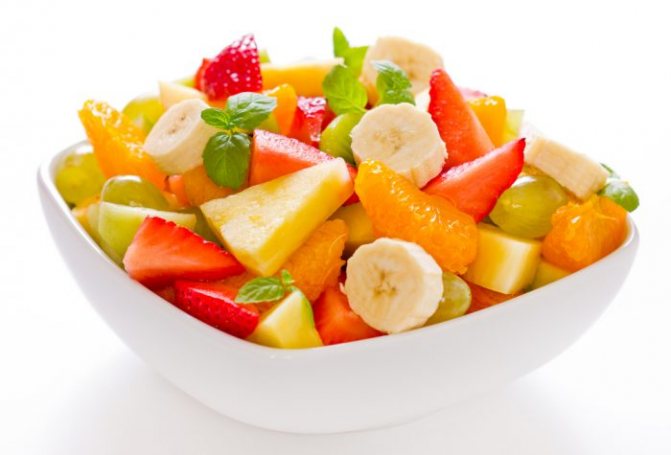The grown-up baby happily devours delicious dishes prepared by his mother on both cheeks. Now his taste preferences are even more pronounced - he has his favorite and not so favorite dishes, as well as clear preferences for certain delicacies. Sometimes we don’t understand why a baby refuses sweets or stubbornly refuses to eat, for example, tomatoes or liver. However, from the experience of many parents, it is known for sure that using any “force” techniques is absolutely useless.
Features of the menu for a 4-year-old child
Now the child eats almost everything: natural meat and fish, all kinds of stews and cereals, any soups, including those with fried roots, onions and carrots. The task of parents is to offer the baby a varied menu so that he receives a full range of vitamins and minerals. Recommended volume of dishes :
- Soups, borscht, pickles, cabbage soup - up to 200 g. On average, this comes out to 1.5–2 ladles. In the summer, they must be seasoned with fresh herbs. Please note that most first courses contain the most vitamins on the first day of preparation - they are destroyed on the second day. At the same time, borscht tastes much better when it is steeped.
- Fish and meat dishes - 70 g. The daily requirement for them is 80-100 g. A separate category is offal - among them the most useful is liver, it can be stewed or fried, dishes made from it help increase hemoglobin.
- The optimal portion of a side dish is 80 g, but if a child asks for more, it’s okay, perhaps he was in the fresh air for a long time and now his appetite has “developed.”
- Vegetable dishes are lower in calories than porridge or potatoes, so the portion can be larger - up to 200 g.
- A baby needs at least 50 g of bread per day. Make sure that there are varieties of both rye and wheat flour on the table.
- Fruits - about 100 g. Do not overfeed your child with them, because everything is good in moderation. In winter, offer your baby citrus fruits, persimmons, and bananas. In general, stick to the main rule - whenever possible, buy fruits that are in season. Agree, strawberries or peaches cannot be obtained naturally in winter, and if they are grown using modern technologies, they are inferior not only in taste, but also in the content of nutrients.
Organization of proper nutrition
The calorie content of food received by a 4-year-old child per day should be 1700 kcal. At the same time, at lunch he should receive at least 40% of them, breakfast will be in second place in calorie content - 30%, the energy value of the afternoon snack - 10%, and dinner - approximately 20%.
Nutrition should be complete in terms of the content of basic nutrients - proteins, carbohydrates, fats. For a 4-year-old child, the need for them is as follows:
- building material for tissues, that is, proteins, requires about 3.5 g per kilogram of body weight;
- fats providing the body with energy – 3 g/kg;
- the main source of energy, which are carbohydrates, is 15 g/kg.
The following products can supply your child’s body with proteins:
- fish;
- eggs;
- meat;
- dairy products (cottage cheese, cheese, kefir, etc.).
Fats come mainly in the form of vegetable oils and butter. A child gets a small part of the fat from meat and fish.
Suppliers of carbohydrates are fruits, cereals, bakery products, vegetables, and sweets.
Products for daily use include:
- meat;
- cereals;
- vegetables;
- dairy products;
- fruits;
- butter (butter and vegetable);
- bread.
Some foods need to be included in the diet 2-3 times a week. These include fish, eggs, cottage cheese. True, if the egg is chicken, then you can give it to the baby every other day, but you can give it 1 quail egg every day.
Daily food intake for a 4-year-old child:
- vegetables - from 250 to 500 g;
- cereals, pasta – 50 g;
- meat – 110 g;
- fish – 60-80 g;
- dairy products – 500 ml;
- fresh fruits – up to 200 g;
- dried fruits – 15 g;
- bread – 170 g (of which rye – 60 g);
- sour cream – 15 g;
- cottage cheese – up to 100 g;
- butter – 30 g;
- vegetable oil – 10 g;
- sugar – up to 60 g;
- salt – 3 g.
Fresh fruits and vegetables play an important role in the diet of a 4-year-old child. These are sources of those minerals and vitamins that cannot be replaced by artificial food additives. Fruits will be better absorbed if you give them to your baby not after lunch, but about an hour before meals or in the afternoon.
The drinking regime for a child is no less important. It is not difficult to calculate the required amount of fluid for each 4-year-old child: 60 ml of fluid is needed per day per 1 kilogram of his body weight. The average volume of liquid per day is approximately 1.5 liters. Most of this volume should be water (boiled or filtered).
In addition, the diet should include compote (from fresh, frozen or dried fruits), tea with milk, freshly prepared vegetable and fruit juices, cocoa, milk and fermented milk drinks, jelly, coffee substitute (barley drink, chicory). Of course, jelly should be made from fresh or frozen berries, but not from an instant package.
New dishes on the menu for a 4-year-old child
New dishes appear in the preschooler's diet: stuffed vegetables - zucchini, eggplant, bell pepper, tomatoes, potatoes. From time to time you can prepare pancakes with a variety of fillings: cottage cheese, cabbage, jam and meat. Children love pancakes no less - both classic ones, made with kefir, and those made from zucchini, pumpkin or other vegetables.
Of course, it is not always possible to spend a lot of time preparing complex dishes, but even simple potato pancakes or fish soup are perceived completely differently if they are decorated creatively. From childhood, accustom your child to aesthetics - serve dishes beautifully, this helps increase appetite.
Dish recipes
Salad "Freshness"
Preparation:
- wash and cut into small cubes 1 apple and 1 small cucumber;
- wash, peel 1 small carrot and cut it into strips;
- wash and cut into thin strips half a sweet pepper, 2 lettuce leaves, 1 sprig of mint or tarragon;
- add 1 tsp. freshly squeezed lemon juice and 2 tbsp. l. sour cream;
- mix all ingredients thoroughly.
Curd and carrot casserole
Preparation:
- wash and peel 200 g of carrots, cut into strips;
- lightly stew the carrots with 10 g of butter;
- add 10 g of semolina to the carrots and cook until tender;
- add a raw chicken egg, 2 tsp. to the cooled carrot mixture. sugar and cottage cheese 80 g;
- grease a baking dish with 10 g of sour cream;
- mix the mixture well and pour into the mold;
- Bake in the oven until done.
Fruit salad

Preparation:
- wash and peel apples, bananas, oranges and grapefruits;
- cut all the fruits into pieces, mix;
- The salad can be seasoned with sour cream or yogurt.
Liver meatballs
Preparation:
- Pour 1 piece of white stale bread with 50 ml of warm milk to soften;
- Grind 350 g of fresh liver in a blender;
- peel, wash and chop half a small onion and simmer it with 1 tsp. vegetable oil;
- grind the bread and combine it with the liver;
- add the yolk of 1 chicken egg and stewed onion to the liver;
- mix everything thoroughly, scoop up the minced meat with a teaspoon, form it into round meatballs, which need to be rolled in flour and cooked for about 15 minutes in salted water.
Pancakes with vegetables
Preparation:
- take 75 g of flour, add a pinch of salt, 6 g of sugar, 1 chicken egg and pour in 150 ml of milk;
- stir thoroughly until the mixture is homogeneous and bake pancakes from the resulting dough, let them cool;
- wash, peel and chop 120 g of carrots, 150 g of white or Chinese cabbage, 30 g of onions;
- fry these vegetables with 10 g of vegetable oil until the vegetables are soft, add a little salt;
- Place the vegetable filling on the pancake and wrap it in an envelope;
- Ready-made pancakes can be lightly fried in a frying pan.
Pumpkin soup
Preparation:
- wash the pumpkin, take a piece of 150 g and cut into small cubes;
- wash and peel 1 medium-sized potato, cut it into small cubes;
- place potatoes and pumpkin in a saucepan with boiling water;
- wash and peel 1 small carrot, grate it and add to the saucepan;
- cook the soup over low heat for half an hour, add 1 tsp. olive oil and a pinch of salt;
- beat the soup with a blender.
Sweets
At 4 years old, almost all children already show interest in sweets. And no matter how much doctors repeat about the dangers of confectionery products, including sweets and cakes, most children love them. What can I recommend here? Of course, there are plenty of temptations, and it’s hard to resist passing by delicacies. In addition, your baby is likely to actively interact with other children. Of course, it will be difficult for him to watch other girls and boys eat ice cream or enjoy cake, so periodically, 1-2 times a week, do not deny him this pleasure.
Is it possible to somehow minimize the harm from sweets? Yes, for example, instead of candy, offer your baby marmalade or marshmallow. In the summer, focus on fruits, as well as a variety of desserts - for example, cottage cheese casserole or yogurt with strawberries, soufflé cakes with apricots or peaches.
Important! The amount of fatty foods should be limited. Always give preference to lean meat; keep in mind that lard can be offered to children only occasionally, for a variety of taste sensations. You should also not overuse confectionery products baked with margarine.
Nutritional features of a 4-year-old child
It is advisable to create a menu in such a way that dishes are repeated as rarely as possible. In addition to crumbly cereals, you can offer your baby vegetable stews, cereal casseroles, puddings and other dishes made from familiar products. Helpful Tips:
- It is better for your baby to prepare fatty foods mainly at lunchtime, or at least in the morning, but not in the evening, since it takes a long time to process.
- The best companion to fatty pork is high-carbohydrate dishes. This “duet” is much easier to tolerate by the digestive system.
- Food compatibility: buckwheat’s ideal partner is milk, this is due to the accelerated absorption of proteins. Flour products should be combined with fish and meat; cottage cheese, kefir or milk are also suitable.
- Coffee is prohibited. If your baby loves cocoa, there is nothing wrong with that, but the proportion of milk in it should be significantly greater than water.
- The daily sugar requirement for a 4-year-old child is 60 g. This includes compotes, confectionery and sweets (sweets, jam and others).
Always consider your child’s tastes - if he categorically refuses to eat boiled beets or, for example, fried onions, it is better not to focus on this. Later, you yourself will not notice how the baby begins to eat these foods.
Making a menu for the day
The health of the child in the future will depend on how well a child’s diet is prepared at the age of 4 years. You should not be negligent in shaping your diet, otherwise in the future the child’s body may react negatively to the lack of vitamins, microelements and other beneficial substances on the menu.
An approximate daily diet for a 4-year-old child could be:
- Breakfast
- any milk porridge (200 g);
- sandwich with butter (5 g) and cheese (10 g);
- a glass of sweet tea with milk or cocoa (200 ml).
- Dinner
- soup or borscht (200 ml) with meat (30 g);
- wheat-rye bread (50 g);
- cottage cheese casserole (120 g) with sour cream (20 g);
- fruits and vegetables (100 g).
- Afternoon snack
- raw grated carrots (70 g) with sour cream or homemade yogurt (10 g);
- bun (50 g) with jam (20 g);
- kefir or fermented baked milk (150 ml).
- Dinner
- stuffed cabbage rolls or peppers (100 g);
- loaf or white bread (30 g) with a piece of butter (5 g) and honey (10 g);
- milk (150 ml).
It is clear that you can use interchangeable products, this is just a sample menu.
The role of fruits in the diet of children
It doesn’t matter whether it’s summer or winter—a child needs fruit every day. Try to keep them fresh, and in the warm season, prepare stocks with minimal heat treatment - this helps preserve vitamins. Using certain fruits you can correct the activity of body systems. So, blueberries will help with diarrhea, and they also strengthen eyesight.
Cranberries and lingonberries are indispensable for inflammatory processes. Raspberries are no less useful - they are an excellent diaphoretic. If your child has low hemoglobin, try to give him as many cherries as possible in the summer - it stimulates the activity of the hematopoietic system.
A pear is suitable for cleansing the genitourinary system, and if you want to rid your child of inflammatory processes in the intestines, offer him applesauce. For frequent constipation, your baby should be given plums - fresh or dried. Tangerines also have a weakening effect.











